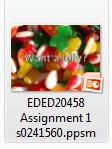53 days ago, after a satisfying lunch, the cohort of 2013 GDLT students sauntered back into Building 5/G.02 to sit through the course session for EDED20491; ICT’s for Learning Design.
And so the journey began...a lecture theatre of 120-odd students unwittingly involved in their first virtual collaboration session, staring blankly at each other while the room filled with jargon.
6 weeks in and already I have demonstrated greater proficiency in digital literacies.

And to what can I credit my new found skills? A heavily scaffolded course design catered for the learning styles of all students, encouraging learning through collaboration and differentiation in a non-threatening online environment .
In the Australian Curriculum, students develop ICT capability as they learn to use ICT effectively and appropriately to access, create and communicate information and ideas, solve problems and work collaboratively in all learning areas at school, and in their lives beyond school. The capability involves students in learning to make the most of the digital technologies available to them, adapting to new ways of doing things as technologies evolve and limiting the risks to themselves and others in a digital environment (Australian Curriculum, Assessment and Reporting Authority [ACARA], 2011a).
Coupled with curriculum content in each learning area, ICT can be used to enhance, support and transform student learning in a meaningful way. Sources liken the www to:
WHATEVER
WHEREVER
WHENEVER
and suggest that digital technologies can provide students with flexibility, freedom and control of what, where and when they learn. This is consistent with the notion of students as 21st century learners, framing ICT as a foundation rather than a tool.
ICT encompasses a diverse set of powerful and enabling technological tools that develop capabilities "associated with information access and management, information creation and presentation, problem solving, decision making, communication, creative expression, and empirical reasoning" (ACARA, 2011b).
The learning potential of this digital culture can be illustrated by the explicit inclusion of such technologies (e.g.
mobile phones and
laptops) in school policies.
This synopsis explores a sample of grouped technological tools, evaluating their affordances and value in pedagogy and student engagement, with reference to learning theories and conceptual frameworks (such as
TPACK and Blooms Taxonomy).
Mobile Phone Wiki
While participation in an
established wiki was mandated, the underlying purpose of this engagement activity was to direct learning to the affordances of collaborative online learning spaces, and the need for effective pedagogical design. Given the "degree of latitude and choice in the activities," (Dane, 2010) it is clear that effective scaffolding is critical to ensure the achievement of appropriate and planned learning outcomes. This was supported by de Bono's 6 Thinking Hats which encouraged a balance of multiple perspectives. Fasso (2013a) links this scaffold to higher order thinking (as prescribed in Blooms Taxonomy). "This activity is about analysis and evaluation. And if you were asked to combine all of the perspectives to make a decision, you are engaging in a synthesis of information. Right at the top of Bloom's Taxonomy."
This blog posting contains my personal reflection on the activity as well as an analysis of learning theories with reference to my wiki comment.
Group 1
The Group 1 tools focused on online spaces; blogs, wiki's and websites. "Whilst these tools are multi-purpose, their strength is in the way they allow information upload, and/or facilitate collaboration and communication amongst students, and between students and guest experts" (Fasso, 2013b). With reference to blogs, these features are illustrated in the hyperlinked postings throughout the synopsis.
By this stage of the course, we had already created and personalised our own blog space, and I had become more than a little attached. I explored the affordances of this tool in a learning context by performing a
PMI analysis.
Blogs can be sequential or global to cater for the individual learning preferences of each student. This synopsis provides a 'global' overview, allowing viewers to click links in order to access additional information.
Posted comments by guest experts (e.g. teacher) can assist students and "scaffold their thinking to reflect the learning they are required to demonstrate. This can be done through thinking tools, or through carefully constructed question sequences" (Fasso, 2013c). It is important to be mindful of the power of feedback, especially in a open environment, as this could either inhibit or foster the learning outcomes of the students who created the profile or those viewing them.
Group 2
These tools drew our attention to multimedia. Being a highly visual learner, I chose to explore
images as part of effective pedagogy. Through my exploration of such tools, it became clear that they support the best learning outcomes when used in conjunction with
other mediums. This is because the collaborative use of these tools can utilise the capacities and cognitive resources of all processing channels. While these tools may prove successful in supporting and scaffolding learning experiences in their own right, "ultimately, it is the master teacher who must align all elements of the learning environment into a cohesive whole" (Saye & Brush, 2002, p. 94).
Group 3
PowerPoint, Prezi's and
Glogsters were grouped as presentation tools, which all have the ability to transform one-dimensional knowledge. The versatile and open ended nature of these tools can support any or all learning theories, depending on:
- the way the learning is scaffolded,
- the way pedagogy is designed and delivered, and
- the task itself.
While face value 'wow' factor may be more prominent in
certain tools, our task was to evaluate the affordances of each in the context of teaching.
I became intrigued by the learning materials scaffolding this weeks tools and started to realise that my use and understanding of PowerPoint had barely scraped the surface of its capabilities and functionality. There was untapped potential here, which I illustrate in the form of a
SWOT analysis.
Group 4
Group 4 tools opened our eyes to the world of possibility, likening our 'ICT's exposure in education' (to date) to the tip of an iceberg.
These tools were open ended and encapsulated everything else.
We have been hearing more and more than Constructivism is messy. In the spirit of messy, I thought I would investigate a tool that would most effectively organise the many thoughts floating around in my head. Bubbl.us is an online conceptual mapping tool, and a great way to visualise thought processes or facilitate brainstorming. I was able to link and build on ideas while drawing connections from prior knowledge and experiences.
My
blog posting contains a thinking routine which analyses the affordances of this tools, as well as providing classroom examples of when such a tool may be effective.
Other considerations
There are many factors which may limit the use, availability or abundance of ICT's in schools.
- While Government initiatives, policies and funding attempt to level the playing field in State Schools, economic inequality will always exist outside of a school environment. Resource poor students may have less exposure and willingness to interact with these tools.
- The establishment of the National Broadband Network supports Siemens views on Connectivism, however "the take up of ICT in education is Australia is strongly dependent on the provision of reception infrastructure" (White, 2008). Internet access and speed in a rural/remote classroom could look very different to a classroom in the centre of a metropolis area.
- Parents may resist the digital age and raise children in a home environment unconducive to the 21st century learning that is occurring in schools. This generational gap may create resistance and could filter down and effect student engagement. It is important to educate parents of the many benefits of ICT to ensure consistency.
With student diversity extending so far as to incorporate ICT, the need for contingencies and differentiation is paramount to ensure delivery of quality learning outcomes for all.
Overarching ICT capability is the application of "social and ethical protocols and practices" (ACARA, 2011c), which I have discussed in detail in
this blog posting.
Summary
Consider the following quote by O'Neil & Knight (2007, p. 54):
To make ICT integral to classroom learning, there needs to be a critical purpose to the ICT tool being there, so much so that if the ICT tool was removed, the 'learning' could not happen.
Consistent with the TPACK framework, the use of technology in schools does not by itself improve the quality of learning. It must be used in balance with content knowledge and pedagogy to support good teaching.
With reference to the tools explored, it appears that the only thing limiting the use of ICT in the classroom is imagination. By keeping abreast of technical developments and creations, I will establish myself as a life long learner and hope to ensue this in my teaching; effectively using and scaffolding up-and-coming technologies to enhance, support and transform student learning.
References
Australian Curriculum, Assessment and Reporting Authority. (2011a). Information and communication technology (ICT) capability. Retrieved 4 April, 2013 from:
http://www.australiancurriculum.edu.au/GeneralCapabilities/Information-and-Communication-Technology-capability/Introduction/Introduction
Australian Curriculum, Assessment and Reporting Authority. (2011b). Information and communication technology (ICT) capability. Retrieved 4 April, 2013 from:
http://www.australiancurriculum.edu.au/GeneralCapabilities/Information-and-Communication-Technology-capability/Introduction/Scope-of-ICT-capability
Australian Curriculum, Assessment and Reporting Authority. (2011c). Information and communication technology (ICT) capability. Retrieved 4 April, 2013 from:
http://www.australiancurriculum.edu.au/GeneralCapabilities/Information-and-Communication-Technology-capability/Organising-elements/Organising-elements
Dane, J. (2010). Teaching in student-centred learning environments. Research and development in higher education: Reshaping higher education, volume 33, 191-202. Retrieved from http://www.herdsa.org.au/wp-content/uploads/conference/2010/papers/HERDSA2010_Dane_J.pdf
Fasso, W. (2013a). Engagement activity 3: Working in a wiki. Retrieved from CQUniversity e-courses, EDED20491 ICT’s for Learning Design, http://moodle.cqu.edu.au/mod/page/view.php?id=115342
Fasso, W. (2013b). Web 2.0. Retrieved from CQUniversity e-courses, EDED20491 ICT’s for Learning Design, http://moodle.cqu.edu.au/mod/page/view.php?id=115356
Fasso, W. (2013b). Digital tool 1: Blogs for learning. Retrieved from CQUniversity e-courses, EDED20491 ICT’s for Learning Design, http://moodle.cqu.edu.au/mod/page/view.php?id=115238
Saye, J., & Brush, T. (2002). Scaffolding critical reasoning about history and social issues in multi-media supported learning environments. Retrieved 2 April, 2013 from: http://africalead.oerafrica.org/wp-content/uploads/2011/10/Saye_Brush_2002.pdf
O’Neill, O. & Knight, B. (2007). E-learning: catalyst for a futures orientation. In Learning management transitioning teachers for national and international change (chap. 6). Frenchs Forest, NSW:Pearson Education Australia.
White, G. (2008). ICT trends in education. Retrieved 6 April, 2013 from: http://research.acer.edu.au/cgi/viewcontent.cgi?article=1001&context=digital_learning


























